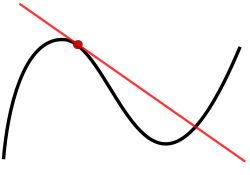computer science, a higher-order function (HOF) is a function that does at least one of the following: takes one or more functions as arguments (i.e. a...
24 KB (2,643 words) - 18:43, 23 March 2025
accumulate, aggregate, compress, or inject) refers to a family of higher-order functions that analyze a recursive data structure and through use of a given...
39 KB (2,787 words) - 17:28, 5 December 2024
In many programming languages, map is a higher-order function that applies a given function to each element of a collection, e.g. a list or set, returning...
23 KB (1,572 words) - 22:24, 25 February 2025
functional programming, filter is a higher-order function that processes a data structure (usually a list) in some order to produce a new data structure containing...
12 KB (600 words) - 16:21, 21 April 2025
Monad (functional programming) (redirect from Bind (higher-order function))
additional natural transformations. So to begin, a structure requires a higher-order function (or "functional") named map to qualify as a functor: map : (a →...
75 KB (9,322 words) - 21:33, 30 March 2025
passed to higher-order functions or used for constructing the result of a higher-order function that needs to return a function. If the function is only...
30 KB (2,284 words) - 13:42, 4 May 2025
mid-1960s. First-class functions are a necessity for the functional programming style, in which the use of higher-order functions is a standard practice...
28 KB (2,524 words) - 08:59, 28 April 2025
Derivative (redirect from Higher-order derivative)
used. Higher order derivatives are the result of differentiating a function repeatedly. Given that f {\displaystyle f} is a differentiable function, the...
57 KB (7,280 words) - 02:12, 21 February 2025
Higher-order programming is a style of computer programming that uses software components, like functions, modules or objects, as values. It is usually...
3 KB (284 words) - 19:32, 29 March 2024
a higher-order function taking or returning a function. A function type depends on the type of the parameters and the result type of the function (it...
7 KB (557 words) - 17:52, 30 January 2023
Higher-order functions are closely related to first-class functions in that higher-order functions and first-class functions both allow functions as arguments...
87 KB (8,696 words) - 10:16, 3 May 2025
f'(x)=3x^{2}-1\rightarrow f'(3)=27-1=26} . The function d is called a "higher-order function" because it accepts another function (f) as an argument. Going further...
9 KB (858 words) - 21:20, 19 November 2024
is a higher-order function that accepts several parsers as input and returns a new parser as its output. In this context, a parser is a function accepting...
13 KB (1,678 words) - 10:15, 11 January 2025
Anamorphism (redirect from Unfold (higher-order function))
function that generates a sequence by repeated application of the function to its previous result. You begin with some value A and apply a function f...
9 KB (1,260 words) - 16:43, 4 November 2024
Zipping (computer science) (redirect from Zip (higher-order function))
programming portal Map (higher-order function) map from ClojureDocs map(function, iterable, ...) from section Built-in Functions from Python v2.7.2 documentation...
11 KB (834 words) - 11:52, 30 April 2025
calculus, function types are used to express the idea of higher-order functions In programming more generally, many higher-order function concepts occur...
9 KB (1,225 words) - 21:01, 28 April 2025
respectively. These are functions that operate on functions or produce other functions; see Higher order function. Examples are: Function composition. Integral...
13 KB (1,407 words) - 06:43, 10 October 2024
OCaml (section Higher-order functions)
(succ) and addition (add). A Church numeral n is a higher-order function that accepts a function f and a value x and applies f to x exactly n times....
39 KB (4,156 words) - 11:55, 5 April 2025
Apply (redirect from Apply (higher-order function))
dictionary. In mathematics and computer science, apply is a function that applies a function to arguments. It is central to programming languages derived...
12 KB (1,449 words) - 17:58, 29 March 2025
combinator (or fixpoint combinator): p.26 is a higher-order function (i.e., a function which takes a function as argument) that returns some fixed point (a...
36 KB (5,183 words) - 19:02, 14 April 2025
data types, pattern matching, parametric polymorphism, currying, higher-order functions, extensible records, channel and process-based concurrency, and...
28 KB (3,274 words) - 05:29, 10 April 2025
Code reuse (section Higher-order function)
families of applications[citation needed]. In functional programming higher-order functions can be used in many cases where design patterns or frameworks were...
16 KB (1,953 words) - 22:06, 26 February 2025
Moment (mathematics) (redirect from Moment of a function)
mathematics, the moments of a function are certain quantitative measures related to the shape of the function's graph. If the function represents mass density...
21 KB (3,066 words) - 21:09, 14 April 2025
square root Functional equation Higher-order function Infinite compositions of analytic functions Iterated function Lambda calculus The strict sense...
37 KB (3,772 words) - 08:50, 25 February 2025
Differential operator (redirect from Order of a differential operator)
an abstract operation that accepts a function and returns another function (in the style of a higher-order function in computer science). This article considers...
22 KB (3,693 words) - 08:09, 21 February 2025
function Higher-order function Homomorphism Morphism Microfunction Distribution Functor Associative array Closed-form expression Elementary function Functional...
76 KB (11,411 words) - 13:49, 24 April 2025
Lambda calculus (redirect from Lambda-definable function)
is a higher-order function—it takes a single-argument function f, and returns another single-argument function. The Church numeral n is a function that...
89 KB (11,994 words) - 17:12, 1 May 2025
Currying (redirect from Curried function)
"currying" is not used, while Curry is mentioned later in the context of higher-order functions. John C. Reynolds defined "currying" in a 1972 paper, but did not...
36 KB (5,025 words) - 17:55, 29 March 2025
first-class functions and higher-order functions in functional programming languages. Specifically, the invoker object is a higher-order function of which...
18 KB (2,418 words) - 06:35, 17 January 2025
structures, automatic storage management, dynamic typing, conditionals, higher-order functions, recursion, the self-hosting compiler, and the read–eval–print loop...
87 KB (10,019 words) - 13:28, 29 April 2025



